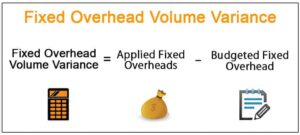Content
1. Meaning of Fixed overhead variance (FOV)
2. Classification of FOV
3. Numerical Solved
4. Variable Overhead Variance
1. Fixed Overhead Variance (FOV)
It is the difference between the Standard fixed overheads and the actual fixed overheads. The fixed overhead variances provide information about, amounts spent by the business on fixed overheads (such as factory rent) that were more or less than expected.
2. Classification of FOV
1. Fixed Overhead Cost Variance’s (FOCV)
2. Fixed Overhead Expenditure Variance (FOEV)
3. Fixed Overhead Volume Variance’s (FOVV)
4. Fixed Overhead Capacity Variance’s (FOCV)
5. Fixed Overhead Efficiency Variance (FOEV)
1. Fixed Overhead Cost Variance (FOCV)
It is the difference between the standard fixed overhead and the actual fixed overhead incurred. It represents the Under/Over Absorbed Fixed Overhead.
Formula
FOCV= Actual Output in Units* Actual Fixed Overheads – Actual Fixed Overhead
Numerical is solved at the end with all the formulas
2. Fixed Overhead Expenditure Variance (FOEV)
The fixed overhead expenditure variance’s the difference between the actual fixed overhead expense incurred and the budgeted fixed overhead expense.
An unfavourable variance means that actual fixed overhead expenses were greater than anticipated. The formula for this variance is:
Formula –
FOEV = Budgeted fixed overhead – actual fixed overhead
OR
=(Budgeted hours*Standard fixed overhead rate) – ( Actual hours*Actual fixed overhead)
3. Fixed Overhead Volume Variance (FOVV)

The fixed overhead volume variances are the difference between the amount of fixed overhead used to produced goods based on production volume, and the amount that was budgeted to produced goods.
The variance arises due to a change in the level of output produced in a period compared to the budget.
Formula
FOVV= Standard rate (Actual quantity-Budgeted quantity
Numerical is solved at the end with all the formulas
4. Fixed Overhead Capacity Variance (FOCV)
It is the difference between the capacity of budgeted hours for work and the actual active hours for work.
This is that portion that arises or is low due to working at higher or lower capacity than the budgeted capacity. Example- Breakdown of machinery, Power Failures, Strikes etc.
FOCV= Standard rate (Standard quantity-budgeted quantity)
5. Fixed Overhead Efficiency Variance
(FOEV)
It is that part of volume variance which shows the lower or higher output arising due to efficiency or inefficiency of workers. It is an outcome of the worker.
Formula : –
= Standard rate (Actual output – Standard output)
WANT TO EARN MONEY???
MAKE CORONA-VIRUS STATS BLOG – GO TO SEE FULL INFORMATION
Demo – Corona-Virus Stats
Numerical – 1
Solve this numerical with the above formulas or Find the variance
| Particulars | Standard | Actual |
| Fixed Overhead | 4000 | 4250 |
| Variable Overhead | 6000 | 5000 |
| Output | 2000 | 1900 |
Solved
1. FOCV= (Actual Output in Units* Standard rate) – Actual Fixed Overhead
= ( 1900*4000/2000)-4250 { Standard rate= Fixed Overhead/Output }
= 3800-4250 = 450 A( ADVERSE )
Comments
It is adverse because actual is more than budgeted or the fixed overhead cost variance’s more than budgeted. Standard rate means how much is fixed overhead for one output.
2. FOEV = Budgeted fixed overhead – Actual fixed overhead
= (4000-4250 )= 250 A (Adverse)
Comments – It is also adverse as budgeted expenditure is less than actual due to an increase in actual overhead expenditure.
3. FOVV= Standard rate (Actual quantity – Budgeted quantity)
= According to the question, we can’t able to find the budgeted quantity as the budgeted quantity is not provided. So we don’t need to find this.
4. FOCV= Standard rate (Standard quantity – budgeted quantity)
= Again , we haven’t budgeted quantity different .
5. FOEV= Standard rate (Actual output – Standard output)
= 2 (1900- 2000) { Standard rate= 4000/2000 }
= 2 (100)= 200 A
Read More- Variable Overhead Variance
amazing sir ji thanks for sharing profitable knowledge
With thanks for sharing your superb website!
Very helpful post. Thanks for sharing such useful information.
Thanks For Sharing The Amazing content. I Will also share with my friends. Great Content thanks a lot.
nice and good of collection and great of information and great of hard work form your side